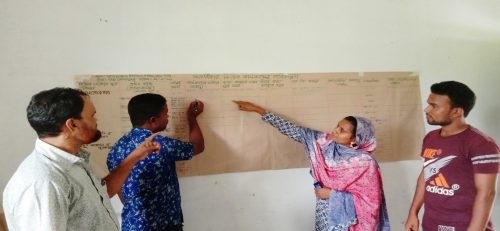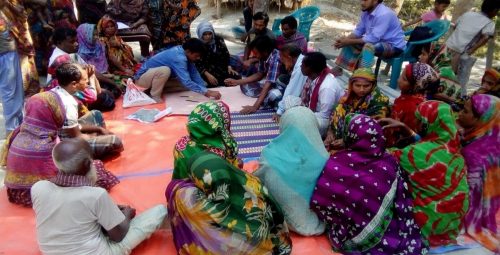Concern Worldwide are working with communities in Bangladesh to understand and enhance their flood resilience. An innovative approach to creating Community Resilience Vision Statements has been key to their achievements. Learn more in this blog.
Concern Worldwide’s flood resilience work in Bangladesh
Concern Worldwide Bangladesh is implementing a Flood Resilience Project as part of the Zurich Flood Resilience Alliance, with funding from the Z Zurich Foundation. We’re working with 22 communities in the North-Western regions of Bangladesh in partnership with local organization Assistance for Social Organization and Development (ASOD).
This area of the country is known for its ever-changing Chars (riverine islands), which are highly susceptible to erosion and severe flooding.
A fragile physical environment, limited access to services and public institutions, highly variable incomes and remoteness all contribute to the vulnerability of Char communities, which is compounded by the almost yearly impacts of monsoon flooding.
The Zurich Flood Resilience Alliance focuses on pre-event resilience building for communities who are most vulnerable to the impacts of floods. Our project in Bangladesh is working towards increased understanding of flood resilience within communities and the enhancement of community voices in developing risk informed resilience actions.
In this project we use the Flood Resilience Measurement for Communities (FRMC) tool, which was developed by the Alliance to engage communities in understanding floods and developing resilience building action plans through a participatory and holistic approach.

Community Resilience Vision Statements help communities grasp complex FRMC process
Community Resilience Vision Statements are a unique innovation developed within our Flood Resilience Project in Bangladesh. The FRMC process requires a holistic appraisal of a community to determine its flood resilience. It’s a complex process which can be difficult to communicate with communities. We found that grounding the communities’ understanding of their flood resilience in Vision Statements was useful, and necessary, to explain the complex process and continuously remind all stakeholders of the purpose of the work.
The communities recognized that floods are a natural phenomenon. We cannot stop or change them. But people can adapt their behaviour and prepare themselves in a manner that reduces the impacts of floods on the community. It’s through this process community flood resilience can be built.
Developing a vision for a flood resilient future
Based on a shared understanding of the flood risk and vulnerabilities, each community developed a vision of where they wanted to see their community’s flood resilience in five years’ time.

The Vision Statements were developed by participants making a list of flood related problems in their community. From that list, they made a shortlist of the issues that are most important to them. Based on the shortlist the community determined their vision elements through agreement in group discussion. From these vision elements, the communities prepared their Vision Statements. These Vision Statements then provided grounding for the FRMC survey.
Using the Community Resilience Vision Statements as a foundation for the FRMC process
The FRMC study findings were analysed against the components of the Community Resilience Vision Statements.
Once we had completed the analysis and grading of the collected data, we shared the FRMC study results with the respective communities for feedback. Before receiving this feedback, the FRMC process was explained to the people in communities we work with so that they could understand the results, and could relate these to their Vision Statements. During this process both agreements and disagreements arose over the results and where necessary communities redefined their Vision Statements.
Disseminating FRMC results and Resilience Vision Statements in communities
To ensure that all community members were aware of the FRMC results they had provided the data for, and were able to engage in developing the Community Resilience Action Plan, communities formed voluntary groups (find out how these developed into Community Resilience Action Groups or CRAGs here). These volunteer groups discussed the FRMC results with their community, dividing them into small groups to ensure greater engagement.

We considered all the feedback as we finalized the FRMC results and the 22 communities’ Flood Resilience Vision Statements.
As part of the process communities prepared Community Resilience Action Plans by engaging a wide variety of participants from the community. Project staff facilitated the process at the community level and documented the Plans, but all inputs came from the community members themselves.
Towards a more flood resilient future
Communities are now implementing, and monitoring the impact of, the activities they planned. Examples are varied and include improving access to health services in Char communities during floods, physical infrastructure repairs or improvements, raising of homesteads and school buildings, and the development of joint plans with local government departments.
Find out more
If you want to learn more about how Community Resilience Vision Statements have been used in Concern’s flood resilience work in Bangladesh you can read this issue of our magazine Knowledge Matters. Find out more about the work Concern and other Zurich Flood Resilience Alliance members are doing in Bangladesh here.

Comments